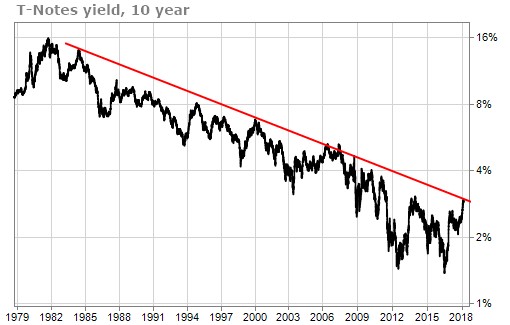The bearishness in US Treasury bonds is palpable these days. T-Notes have been in a downtrend in recent weeks and are sitting near 3-year lows. Everyone seems to agree that the 30-year bull market in bonds (and bear market in bond yields) is over and that higher long-term interest rates are inevitable.
I say – not so fast.
We can tell Wall Street is bearish on treasury bonds because speculators – a grouping which includes hedge fund managers and commodity trading advisors (CTAs) – are now short Treasury bond futures in record levels. This group has never before had such a large bearish position in Treasury futures contracts.
In the Commitment of Traders (COT) data from the T-note futures market, the commercials group is pitted against the speculators group. Futures markets are “zero sum,” meaning there is a short for every long, and the two groups take the opposite side of each other’s positions. When speculators are short, the commercials are long and vice versa.
As the speculators have gone short (bearish) Treasury futures contracts in record levels, the commercials have established record-breaking long (bullish) positions on the other side of the same trade. You can see this in the chart below.

As a rule of thumb, the commercials are the “smart money” in futures contracts. When the commercials are net long to an extreme degree, the market tends to turn their way (i.e. turn and go higher).
You can see this in the chart above. Look to the circled areas below the main price chart. Those circles show outlier changes in positioning, where the commercials were heavily net long (and speculators net short). When one of those extremes takes place, bonds have a tendency to move higher.
Treasury bond prices move in the opposite direction of interest rates. So, when bond prices rise, interest rates fall and vice versa. Interest rates have been falling for decades (and bond prices rising). Much of Wall Street now thinks inflation is making a comeback, which means interest rates finally moving higher.
But as we can see from the multi-decade interest rate chart shown below, interest rates are still below trendline resistance levels… for a downtrend established all the way back in the early 1980s!

Our cycles analysis for T-note futures contracts is also bullish. This gives further weight to the possibility that Treasury bond prices will rise. And remember, when bonds rise, interest rates decline.

Increasing investor fear and growing concern over the newfound volatility in markets is causing a shift out of equities and back into bonds. After a long stretch of incredibly low volatility – by some measures the lowest in more than half a century – the S&P 500 index lost 3.9% in February, its wildest and most volatile month in years.
At the same time, investors have reason to be cautious. They are worried about the possibility of Federal Reserve interest rate hikes, and also new possibilities of an American trade war with China. If investors stay nervous, they may increasingly start selling risk assets and putting the money in Treasury bonds in what is known as a “flight to safety” trade.
If that happens, it could create a positive feedback loop for bonds and a negative one for stocks, as rising bond prices and falling long-term interest rates would make investors even more concerned about the health of the US economic recovery.
To easily track what bonds are doing, you can watch TLT, the popular Treasury bond ETF. If TLT continues to rise and interest rates fall, that would be a self-fulfilling prophesy of increasing fear and caution.
The stock market is looking increasingly shaky (more on that this coming Tuesday). My “Spidey-sense” tells me that investors may soon be feeling nostalgic for the long-term interest rates they could have locked in today.





